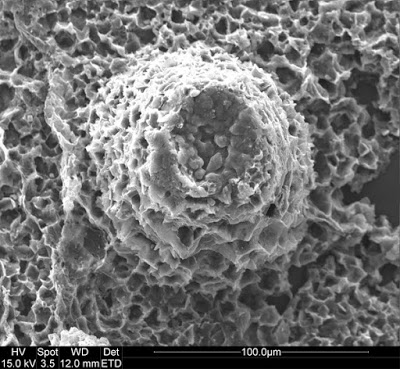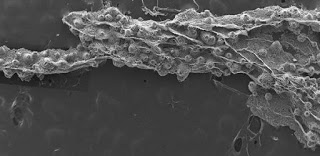
Researchers have discovered what they think are fossils of a unique red algae species that lived about 650 million years ago during a brief respite between some of the most extreme ice ages the world has ever known. The fossils could speak to how life coped in the aptly named Cryogenian period, when glaciers held most of Earth in a frozen grip.
“The reason we were looking at these samples in the first place is that they come from a really interesting time period in Earth’s history, right between two major global glaciations called Snowball Earth events,” said Phoebe Cohen, the study’s lead author and an assistant professor of geosciences at Williams College, in Williamstown, Mass. “We want to understand how these glaciations affected the evolution of life.”
Learning how life on our planet changed under the extreme conditions of back-to-back Snowball Earths—separated by just 10 million years, a relatively short gap in geological time—should shed light on how extraterrestrial life deals with the vicissitudes of nature.
“We are fundamentally interested in the co-evolution between our planet and the life that inhabits it,” said Cohen. “We want to know: What can this teach us about how life might evolve on other planets?”
The new study appeared in the March issue of the journal Palaios and was funded by grants from the NASA Astrobiology Institute element and the Exobiology & Evolutionary Biology element of the NASA Astrobiology Program.
Identifying what once was
The fossils, uncovered within layered rocks in southwestern Mongolia, consist of thin, flat sheets with bumpy protuberances on one side. “These samples look like weird scraps of stiff slime with tiny warts on them,” said Cohen.
The fossil sheets are only between 50 and 350 micrometers, or millionths of a meter, in thickness. (For comparison, a human hair is about 100 micrometers in girth.) Tiny, round bumps as tall as 230 or so micrometers rise and here from the sheets, whose undersides are featurelessly smooth.
The tops of the bumps have a small depression in them, much like the warts that grow on human skin caused by viruses. Ridges of material, meanwhile, skirt the bumps and intersect or split in places, forming structures that look like flaps.
Compared to most organism remains, both before and after the emergence of these warty sheets, these fossils have a superficial resemblance to “biofilms.” These films are composed of bacteria that join together and secrete a gooey, protective substance. The fossils also bear a resemblance to groups of microbes, such as amoebas, that similarly link up to form so-called slime molds.

But the best match given all of the fossils’ features is red algae. This group of creatures includes many seaweeds and other types of marine plants.
A telltale identifier is the bumps, which Cohen and her colleagues think served as reproductive structures. “They are similar in a lot of ways to reproductive structures in modern red algal groups,” said Cohen.
The function of the ridges on the wart-like mounds, however, remains a conundrum.
“We aren’t sure what they are,” said Cohen, “but the fact that they don’t have a modern comparison, frankly, is not surprising to me at all.”
As Cohen pointed out, the organisms preserved as warty sheets have been extinct for hundreds of millions of years. “So much evolution has happened within the red algae since then,” Cohen said. “Some things stay the same, or similar, like reproductive structures, but other things, like these ridges, may have once had a function that we don’t yet understand.”
One theory is that the ridges provided some sort of structural support to the organism, “like corrugated cardboard,” Cohen said. Even so, any strong claims about the ridges’ ultimate purpose are difficult to make given the small amount of fossil material to work with and a limited knowledge of the environment where the wart-shaped microbes went about their daily lives.
An eon of red algae?
Notably, the new red algae fossils—if that is indeed what they are—fill a gap in the fossil record documenting the rise of this marine plant group. The oldest known sample of red algae goes back about a billion years. Fossils reckoned to belong to the same lineage then do not appear again until about 600 million years, well after the glaciers of the second Snowball Earth had receded.
Neither the red algae fossils from a billion years ago, nor those from shortly after the Cryogenian period’s end, possess the ridge and flaplike structures of the newfound fossils. “In this case, we’re seeing a new morphology show up in between these two Snowball Earth events,” said Cohen.
The “why” remains unknown, but future finds could provide clues.
“New fossils always give us more information about how groups of organisms evolved, and potentially why as well,” said Cohen. “So adding more fossils to the record of red algae helps us get a better picture of how this major group of algae evolved, and in what context.”
Life’s steadfastness
Red algae as a branch in the tree of life seems to have weathered the storm of two globe-spanning glaciations. “We know red algae are around before the first Snowball Earth event, in between the two, and after,” said Cohen. “In my opinion, that’s an impressive feat, and it makes predictions about what these events were like.”
For instance, in order for life like algae to have survived, water must have remained unfrozen in at least some pockets on the planet. Overall, Cohen is encouraged by what the findings show of the resiliency of life in a broader, astrobiological perspective. “Once life gets going, it seems pretty hard to extinguish,” said Cohen “You can freeze it, throw giant meteors at it, change the air it has to breath, and it keeps on evolving and adapting and expanding.”
“Hopefully, what is true for life on Earth will also be true for life elsewhere,” Cohen added, “and that persistence will increase the likelihood of us identifying life elsewhere in the Universe.”
Note : The above story is based on materials provided by Astrobio.net
This story is republished courtesy of NASA’s Astrobiology Magazine. Explore the Earth and beyond at www.astrobio.net .










